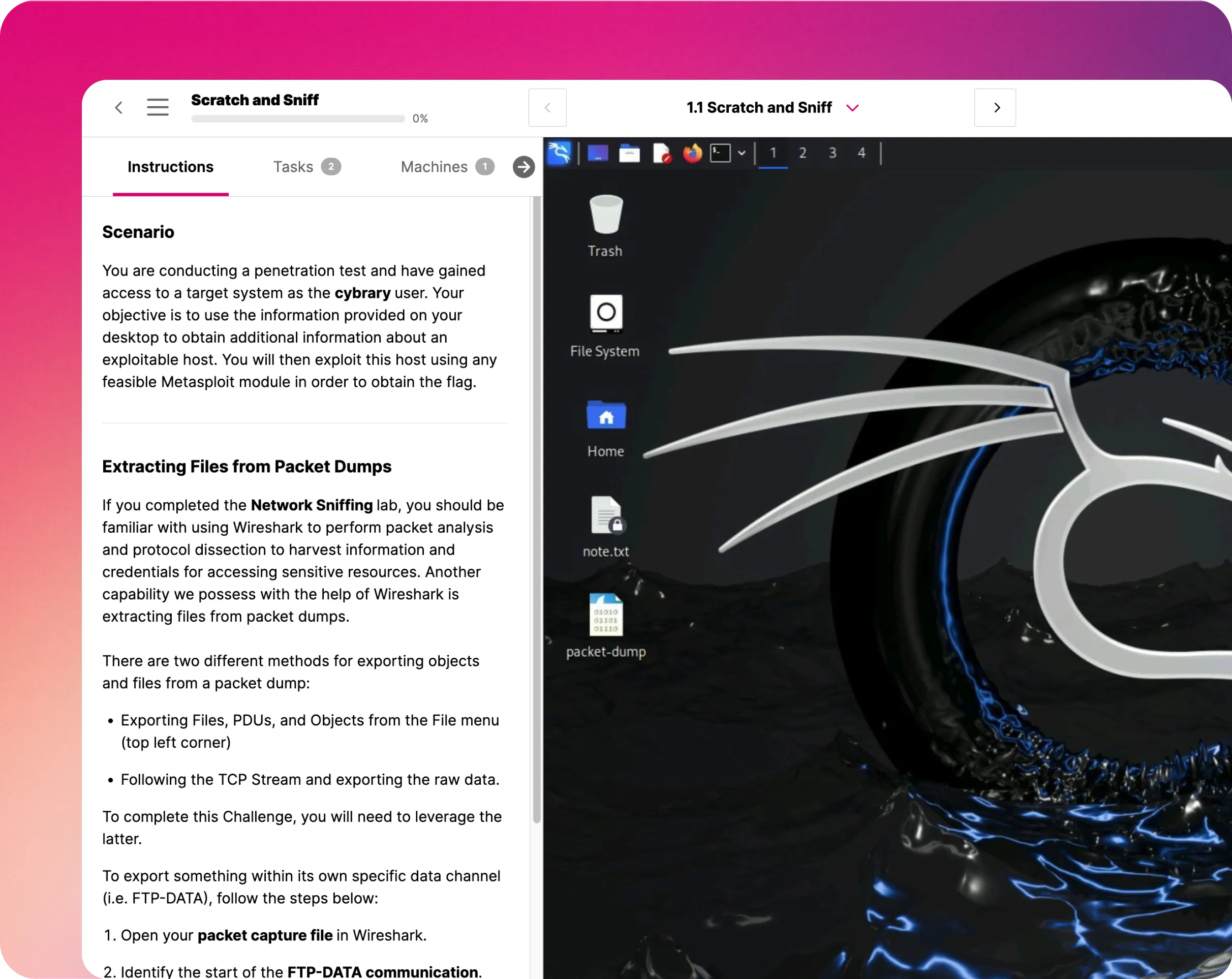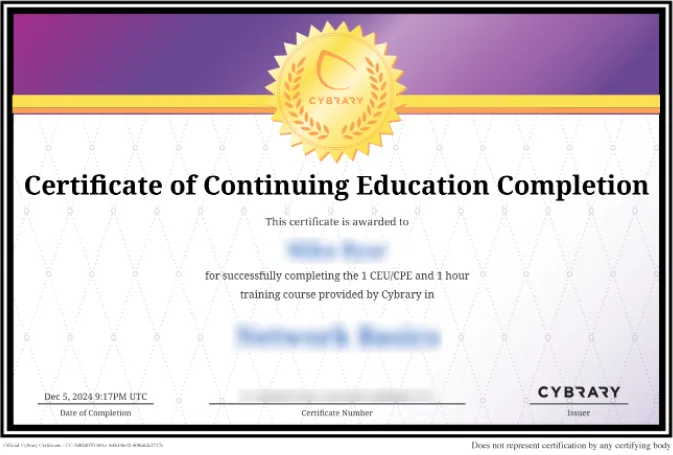IT & Cybersecurity Foundations
Any career in cybersecurity begins with learning a diverse range of IT and Cybersecurity concepts. This career path is designed to provide you with the foundational knowledge and skills required to enter the cybersecurity workforce.

45
H
40
M
Beginner
15060
32
Learners at 96% of Fortune 1000 companies trust Cybrary
About this Career Path
Cybrary’s IT and Cybersecurity Foundations career path will equip you with a strong foundation of cybersecurity knowledge and hands-on skills. Over the course of 30 courses and hands-on virtual labs, you will learn essential IT concepts, security best practices, and the technical skills needed for entry-level IT and cybersecurity roles.
Our courses feature thoughtful, bite-sized content from expert instructors who have helped thousands of other beginners grasp fundamental IT and cybersecurity topics.
Skills you'll gain
- Operating system fundamentals
- Network fundamentals
- Cybersecurity fundamentals
- Scripting and programming fundamentals
- Wireshark, NMAP, cryptography, firewall, IDS, and vulnerability scanner basics
Path Outline
Collection Outline
Coming Soon
The Leadership and Management Career Path is expected to release in Q2 of 2025. Sign up now to explore our other leadership courses and content.
Start Learning for FreeLearn
Learn core concepts and get hands-on with key skills.
Cybrary Orientation

Welcome to Cybrary! In this brief course, you will learn how to get the most of out Cybrary. You will learn how to navigate the Cybrary Learning Interface, enroll in a Cybrary Path, complete a Virtual Lab, and track your progress.
Careers In Cybersecurity

Network Basics

This brief course is designed to introduce you to fundamental networking and network security concepts. You will learn basic networking terminology and topics like the CIA triad, networking models, common ports and protocols, common network-based threats, and network infrastructure security.
Cybersecurity Basics

This brief course is designed to introduce you to fundamental cybersecurity concepts and terminology. You will learn about security controls, access management, data protection, encryption, incident response, GRC, and more.
Linux CLI Basics

In this hands-on lab, you will learn the basics of the Linux Command Line Interface. You will learn and practice several common Linux commands.
Linux File System Basics

In this hands-on lab, you will learn the basics of the Linux file system. You will practice using the Linux CLI to navigate the Linux file system and explore important directories.
Network Reference Models

In this hands-on lab, you will learn about the OSI and TCP/IP Reference Models and how they are used to organize the communications standards used by computer networks. You will then explore the different layers of the two models using Wireshark and a PCAP file containing wireless network traffic.
IP Addressing Basics

In this hands-on lab, you will learn the basics of IP addressing. You will practice analyzing a TCP/IP network topology in the GNS3 network simulator using basic Linux commands.
Network Device Basics

In this hands-on lab, you will learn the basics of network devices. You will practice assessing and configuring a simple network topology in the GNS3 network simulator.
Cryptography Basics

In this hands-on lab, you will learn about the basics of cryptography and the cryptographic process. You will practice encrypting and decrypting messages using a simple simple ciphe
Symmetric Cryptography

In this hands-on lab, you will learn about the basics of symmetric cryptography. You will practice encrypting and decrypting messages using symmetric cryptography.
Asymmetric Cryptography

In this hands-on lab, you will learn about the basics of asymmetric cryptography. You will practice encrypting and decrypting messages using asymmetric cryptography.
Cryptographic Hash Functions

In this hands-on lab, you will learn about the basics of cryptographic hash functions. You will practice generating and comparing hash values.
Windows CLI Basics

In this hands-on lab, you will learn the basics of the Windows Command Line Interface. You will learn and practice several common Windows commands.
Windows File System Basics

In this hands-on lab, you will learn the basics of the Windows file system. You will practice using the File Explorer and the Windows CLI to navigate the Windows file system and explore important directories.
Windows Services

In this hands-on lab, you learn the basics of Windows Services. You will explore several key Windows Services using the Service Control Manager and PowerShell, and demonstrate the risks associated with unquoted service paths.
Access Control Basics

In this hands-on lab, you will learn the basics of access control, including different types of access control. You will practice using Windows Security Permissions and icacls to manage and verify and access control.
Data Backup and Recovery Basics

In this hands-on lab, you will learn the basics of data backup and recovery, including different types of backups. You will practice using Windows Server Backup to create a data backup and recover files from a data backup.
Antivirus Basics

In this hands-on lab, you will learn the basics of antivirus software. You will practice using Windows Defender Antivirus to detect and remove malware from a Windows system.
Wireshark Basics

In this hands-on lab, you will learn the basics of Wireshark, including basic functionality and practical applications. You will practice packet capture and analysis using a range of different protocols and Wireshark features, including display filters, streams, and conversation filters.
Nmap Basics

In this hands-on lab, you will learn the basics of Nmap, including basic functionality and practical applications. You will practice scanning and enumeration using a range of different Nmap options.
VPN Basics

In this lab, you will learn the basics of Virtual Private Networks (VPNs). You will practice configuring a site-to-site IPsec VPN implementation using two pfSense firewall appliances.
Network Troubleshooting Basics

In this hands-on lab, you will learn the basics of network troubleshooting. You will practice using common network troubleshooting tools and techniques to diagnose and resolve various network connectivity issues.
Active Directory Basics

In this hands-on lab, you will learn the basics of the Domain Controller and Active Directory features of the Windows Server operating system. You will practice configuring a Domain Controller and using Active Directory to manage users and groups.
Group Policy Basics

In this hands-on lab, you will learn the basics of Group Policy. You will explore Group Policy at the local and domain level, and use the Group Policy Management Console to create Organizational Units and link Group Policy Objects.
Firewall Basics

In this hands-on lab, you will learn the basics of firewalls, including core functionality and practical applications. You will practice writing, setting, and validating rules using the host-based iptables firewall on a Linux system.
IDS Basics

In this hands-on lab, you will learn the basics of Intrusion Detection Systems (IDS), including basic functionality and practical applications. You will practice creating Snort rules to detect specific types of network traffic and validate those rules.
Vulnerability Scanner Basics

In this hands-on lab, you will learn the basics of vulnerability scanners, including basic functionality and practical applications. You will practice configuring and analyzing scans using the OpenVAS vulnerability scanner.
Patching Basics

In this hands-on lab, you will learn the basics of vulnerability scanners, including basic functionality and practical applications. You will practice configuring and analyzing scans using the OpenVAS vulnerability scanner
PowerShell Basics

In this hands-on lab, you will learn the basics of PowerShell. You will practice using common cmdlets to navigate files and folders and gather system information. You will also use PowerShell to create scripts for automating simple tasks.
BASH Scripting Basics

In this hands-on lab, you will learn the basics of BASH Scripting. You will practice using BASH to run simple one-liners, create arrays, and build re-usable scripts.
Python Basics

In this hands-on lab, you will learn the basics of Python. You will practice using several key Python concepts using the REPL interactive shell, as well as develop a simple script using VS Code.
Practice
Exercise your problem-solving and creative thinking skills with security-centric puzzles
Rank and File

In this hands-on challenge, you will practice navigating Windows and Linux file systems.
Public Service Announcement

In this hands-on challenge, you will practice compromising a vulnerable Windows service
Jumping the Wireshark

In this hands-on challenge, you will have the opportunity to put your Wireshark skills to the test.
Troubleshooting in Paradise

In this hands-on challenge, you will practice troubleshooting issues in a simulated network using GNS3.
Out of Access Control

In this hands-on challenge, you will practice configuring access control lists for a series of folders.
Earth, Wind, and Firewall

In this hands-on challenge, you practice configuring rules for an iptables firewall.
Cryptography Keeper

In this hands-on challenge, you will practice decrypting encryption keys using SSL. For this challenge, you are encouraged to apply your knowledge of BASH to expedite the process with a script.
The PowerShell and the Glory

In this hands-on challenge, you will practice your PowerShell scripting skills by creating a simple script.
Et tu Python?

In this hands-on challenge, you will practice your Python scripting skills by finishing a partially-complete script.
Windows CLI Basics

In this hands-on lab, you will learn the basics of the Windows Command Line Interface. You will learn and practice several common Windows commands.
Prove
Assess your knowledge and skills to identify areas for improvement and measure your growth
Network Fundamentals

Operating System Fundamentals

Test your Operating System Fundamentals knowledge and skills to identify strengths, gaps, and weaknesses in areas like command line interfaces, file systems, active directory, and more. Measure your mastery of Operating System Fundamentals and advance your career with targeted course and virtual lab recommendations.
Cybersecurity Fundamentals

Test your Cybersecurity Fundamentals knowledge and skills to identify strengths, gaps, and weaknesses in areas like cryptography, access control, firewalls, vulnerability scanning, and more. Measure your mastery of Cybersecurity Fundamentals and advance your career with targeted course and virtual lab recommendations.
Scripting and Programming Fundamentals

Test your Scripting and Programming Fundamentals knowledge and skills to identify strengths, gaps, and weakness in areas like PowerShell, BASH, and Python. Measure your mastery of Scripting and Programming Fundamentals and advance your career with targeted course and virtual lab recommendations.
Train Your Team
Cybrary’s expert-led cybersecurity courses help your team remediate skill gaps and get up-to-date on certifications. Utilize Cybrary to stay ahead of emerging threats and provide team members with clarity on how to learn, grow, and advance their careers within your organization.
Instructors









Instructors




























Learn
Learn core concepts and get hands-on with key skills.

Practice
Exercise your problem-solving and creative thinking skills with security-centric puzzles

Prove
Assess your knowledge and skills to identify areas for improvement and measure your growth

Get Hands-on Learning
Put your skills to the test in virtual labs, challenges, and simulated environments.

Measure Your Progress
Track your skills development from lesson to lesson using the Cybrary Skills Tracker.

Connect with the Community
Connect with peers and mentors through our supportive community of cybersecurity professionals.
Success from Our Learners
Frequently Asked Questions
This career path is designed for learners who have no prior experience in IT or Cybersecurity, but are interested in pursuing a career in this exciting field. Learners should have a working knowledge of modern technology, basic analytical skills, and a strong desire to learn. Previous on-the-job experience in IT or cybersecurity is not required.
Responsibilities and job requirements vary greatly across IT and cybersecurity functions, but here are some tasks you may be responsible for in an entry-level IT or cybersecurity role:
- Monitoring and managing networks and systems
- Troubleshooting hardware and software issues
- Maintaining IT infrastructure
- Identifying security vulnerabilities
- Implementing security measures
- Ensuring systems meet compliance guidelines
- Using programming languages to automate security tasks
Test your Scripting and Programming Fundamentals knowledge and skills with this brief assessment. Identify your strengths, gaps, and weaknesses, and get targeted course and virtual lab recommendations to improve your scores and measure your skills development growth.
You will answer questions and complete tasks on PowerShell, BASH, and Python.
Prove your capability as an effective cybersecurity professional to yourself, your boss, or prospective employer












